- Sort by Default Order
- Display 15 Products per page


PDF map files available for download from the FLTC On-line Store are geospatial-enabled. This means that the files can be imported into mapping software available for many Apple and Android smart phones and tablets, and soon for Windows Phones.
We have tested our PDF maps with the Avenza PDF Maps Mobile App. Once you have installed this (free) app on your device, you can import the FLTC PDF map into the application.
Then, when you are hiking within the boundaries of the map, you can see your location acording to your device’s GPS. You can also do things like:
The free version of the Avenza app will only permit you to import three maps at one time. To import an additional map, you must first remove one of the three from the app. You can still keep the PDF files on your device and switch them at any time. There is a subscription version available from Avenza that will permit you to import an unlimited number of maps.
You can also purchase PDF versions of FLT maps from Avenza, and for purchased maps, there is no limit to the number you can import.
Consult with this page for notices of trail conditions before you leave for your hike. Click on the “Sort by” option to sort the notices by map name or by date. Don’t know your map name? Go to the index map look for the name (M09 or M9 for example) nearest your hike location.
When sorted by map name, the notices are listed going from west to east on the main trail, and then north to south on the branch trails (south to north on Conservation and Onondaga trails). Click on the map names above the table to jump to the notices for a particular map. You can then scroll up and down to view other nearby notices.
The date of the most recent major revision is shown for each map. Check the revision date on your map to see if it might be outdated. All changes to maps—both major revisions and minor updates—are reported as Trail Notices highlighted in pink. Use these notices to decide when you want to replace an outdated map.
When sorted by Date the notices are listed with the most recent notices anywhere on the FLTC system listed first.
Some older notices have been archived as they may contain information that is still useful if you have not visited the trail recently. Click the “Archived” link to view these notices.
Trail conditions change frequently. You can help by reporting problems you see. But please read How to Report Trail Conditions before submitting your report.
Trail Conditions are posted when reported and verified. Conditions are rectified if and when volunteers are available.
The FLT is a “primitive footpath.” If you are looking for a smooth, easy “walk in the park” then you might prefer a park for your walking. On the other hand, if you are looking to challenge yourself and get away from “engineered” experiences, then come to the Finger Lakes Trail.
Nevertheless, we want the condition of the Finger Lakes Trail to be the best it can be. Every section of the trail is maintained by stewards and trail adopters who are members of the FLTC and affiliate clubs and organizations. These people volunteer their time because they care about the Finger Lakes Trail. They also care about your experience on the trail. They visit their section of trail several times each year to look for problems: trail erosion, litter, vegetation infringement on the trail, fallen trees and branches, blazes and signs that need to be replaced or refreshed, and infrastructure that needs repair. In short, they look for things that will interfere with your wilderness hiking experience.
Trail volunteers also interact with our private landowners who have agreed to share a portion of their property with FLT hikers. Our volunteers are the first to know when land ownership may change, or when the landowner has had a problem on their section of trail.
Whether you are a new or experienced hiker, if you find a problem on the trail, let us know! Visit the Trail Condition Reporting page for more information.
Remember, some sections of the trail are closed during hunting seasons which include Spring and Fall turkey seasons, and Fall big game seasons. Closures are listed in red in the Trail Condition Notices. Dates are listed on Hunting Season Schedules.
And, when you are ready, join us as a volunteer to help keep the Finger Lakes Trail one of the best hiking trails in the world.
We revise paper maps, PDF files, and GPX files when trail conditions change significantly. When we do, we change the Revision Date of the map. We also apply minor updates to our maps as needed, and for these, we do not change the Revision Date. For all map changes, we post a Map Revision Notice on the Trail Condition Notices page on the website. You can use both the revision date and the Map Revision Notices to decide if you want to purchase a fresh copy of a map.
We do not change our maps for temporary conditions such as logging closures, storm damage, or special events, but we do post Trail Condition Notices.
We encourage hikers to always check the Trail Condition Notices page before hiking even if their maps are up to date. Here is a short tutorial:


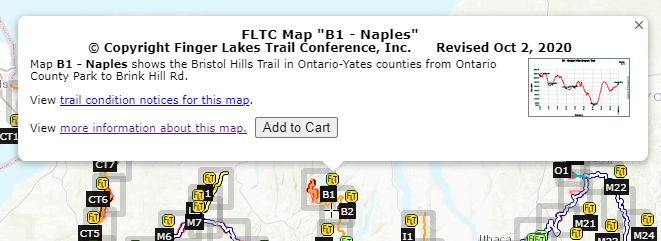

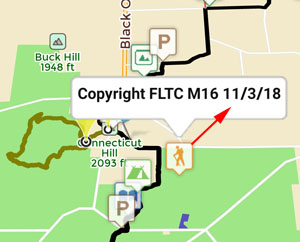
We hope that this information will help you keep your maps and understanding of trail conditions up to date for the most satisfying and safe experience on the Finger Lakes Trail.
| The interactive maps may not display correctly in some browsers. For best results, use Firefox, Chrome, Edge, or Safari. If you are having trouble, try the segmented version of the map here. |
 This is an overview map of the Finger Lakes Trail System. It shows tracks of the main trail, branch trails, loops and spurs. The track colors represent the blaze colors for the branch trails, loops, spurs, and sections of the main FLT not blazed in white. Most of the main FLT is depicted in black & white for better visibility on various map backgrounds, but blazed in white on the ground. Trail closures (hunting, logging, etc.) and recommended bypass routes are depicted as shown at right. Hover over a track to display the name and length. Tracks colored magenta and labeled “Non-FLT” show approximate location only and may not represent the condition and location of the trail on the ground.
This is an overview map of the Finger Lakes Trail System. It shows tracks of the main trail, branch trails, loops and spurs. The track colors represent the blaze colors for the branch trails, loops, spurs, and sections of the main FLT not blazed in white. Most of the main FLT is depicted in black & white for better visibility on various map backgrounds, but blazed in white on the ground. Trail closures (hunting, logging, etc.) and recommended bypass routes are depicted as shown at right. Hover over a track to display the name and length. Tracks colored magenta and labeled “Non-FLT” show approximate location only and may not represent the condition and location of the trail on the ground.
When you zoom in on a trail section, trailheads, notices, and important infrastructure such as lean-tos are also shown.
| Click the menu button in the upper right for commands to Change the map background and Adjust map opacity, | |
| Click the button in the upper right to view the map in the full window. Then click the geolocate button to show your present GPS location on the map. | |
| The following symbols appear on the map (use the Hide/Show Symbols menu in the upper right to control symbol visibility): | |
| Information about FLTC Maps, Also, connect to Trail Condition Notices directly from the |
|
| Trailhead with parking. Click the symbol for more information and for driving directions. | |
| Parking prohibited by law or landowner request. | |
| Parking Advisory – Limited or poor parking; some have nearby alternatives. | |
| Camping, including lean-tos, bivouac sites, public and private campgrounds. See Lean-tos, Bivouac Areas, and Campgrounds for more information | |
| Hunting closures. See Hunting Season Schedules for more information. | |
| Potable water | |
| Water source – TREAT BEFORE DRINKING | |
| FLT Passport hike is nearby. Click the icon to view details, obtain a map, or obtain the guidebook. | |
| Google street view. Drag the icon onto highlighted streets and click. (For more information) | |
| ½-mile tickmark – hover over a tickmark to display the mileage along the trail segment (Use Hide/Show Symbols menu to show the tickmarks). | |
| Connections to other long-distance hiking trails. | |
 |
Enter GPS coordinates (Latitude, Longitude) or an address (street address, town, or zip code) and click Find to recenter the map at that location. |
| Click on the center tool to show a small cross-hair in the center of the map. The tool shows the coordinates of the center if you pan or scroll the map. |
| The interactive maps may not display correctly with Internet Explorer. For best results, use Firefox, Chrome, Edge, or Safari. If you have a fast computer and fast network connection, you can try the unsegmented Full System version of the map here. |
 This is a overview map of the Finger Lakes Trail System. It shows tracks of the main trail, branch trails, loops and spurs. The track colors represent the blaze colors for the branch trails, loops, spurs, and sections of the main FLT not blazed in white. Most of the main FLT is depicted in black & white for better visibility on various map backgrounds, but blazed in white on the ground. Trail closures (hunting, logging, etc.) and recommended bypass routes are depicted as shown at right. Hover over a track to display the name and length. Tracks colored magenta and labeled “Non-FLT” show approximate location only and may not represent the condition and location of the trail on the ground.
This is a overview map of the Finger Lakes Trail System. It shows tracks of the main trail, branch trails, loops and spurs. The track colors represent the blaze colors for the branch trails, loops, spurs, and sections of the main FLT not blazed in white. Most of the main FLT is depicted in black & white for better visibility on various map backgrounds, but blazed in white on the ground. Trail closures (hunting, logging, etc.) and recommended bypass routes are depicted as shown at right. Hover over a track to display the name and length. Tracks colored magenta and labeled “Non-FLT” show approximate location only and may not represent the condition and location of the trail on the ground.
When you zoom in on a trail section, trailheads, notices, and important infrastructure such as lean-tos are also shown.
| Click the menu button in the upper right for commands to Change the map background and Adjust map opacity, | |
| Click the button in the upper right to view the map in the full window. Then click the geolocate button to show your present GPS location on the map. | |
| The following symbols appear on the map (use the Hide/Show Symbols menu to control symbol visibility): | |
| Click for information about FLTC Maps, |
|
| Trailhead with parking. Click the symbol for more information. GPS coordinates, and for driving directions. | |
| |
Parking prohibited by law or landowner request. |
| Parking Advisory – Limited or poor parking; some have nearby alternatives. | |
| Camping: lean-tos, bivouacs, public and private campgrounds. See Lean-tos, Bivouacs, and Campgrounds for more information | |
| Hunting closures. See Hunting Season Schedules for more information. | |
| Potable water |
|
| ½-mile tickmark – hover over a tickmark to display the mileage along the trail segment (Use Hide/Show Symbols menu to show the tickmarks). | |
| Connections to other long-distance hiking trails. | |
 |
Enter GPS coordinates (Latitude, Longitude) or an address (street address, town, or zip code) and click Find to recenter the map at that location. |
| Click on the center tool to show a small cross-hair in the center of the map. The tool shows the latitude and longitude coordinates of the center if you pan or scroll the map. | |
| Select a map background from the list in the upper right. Use the menu icons to find tools to measure distance and control background opacity. |
As a trail Section Maintainer (called Steward or Adopter by some clubs) you assume responsibility for a section of the Finger Lakes Trail, generally 1 or 2 miles in length. Working for your club or trail sponsoring organization, or as an individual trail sponsor under one of the FLTC’s volunteer Regional Trail Coordinators, you agree to visit your section three times per year. You perform routine inspection and maintenance: clear vegetation and fallen branches, pickup litter, refresh blazes and signs as needed, check up on trail infrastructure such as register boxes, benches, bridges, lean-tos, etc.
To access the services of a roving certified chainsaw operator or for anything else you can’t handle yourself, you will contact your club or organization’s trails chairperson, or the FLTC’s Regional Trail Coordinator who oversees your area. They will help you organize a work day with a local work crew.
You will keep a log of your activities and report total hours of trail work, drive time, and administrative work, and report it to your trails chairperson or sponsor.
You will also be invited to attend occasional training meetings in your region.
Since our volunteer trail maintainers don’t visit the trail every day, we depend on you to notice and report trail conditions that need to be corrected. It could be a safety issue or just an inconvenience, but let us know about it. On the other hand, remember that the Finger Lakes Trail is a “primitive footpath” so that some conditions such as a steep rocky section, an occasional “step-over” log, or a section that is muddy in some seasons, are a natural part of the experience.
Please submit your trail condition reports by e-mail at [email protected]. If you do not have e-mail, call the FLT Service Center in Mount Morris at (585)658-9320. During times when the office is not open, please leave a voice message with a daytime phone number where we can reach you for more information.
Describe the problem clearly, being as specific as possible as to the location and nature of the problem. Include as much of the following as possible:
Give your best estimate of what is needed to correct the problem; we hate to send a crew with chainsaws only to find a small tree that could have been handled by one person with a handsaw.
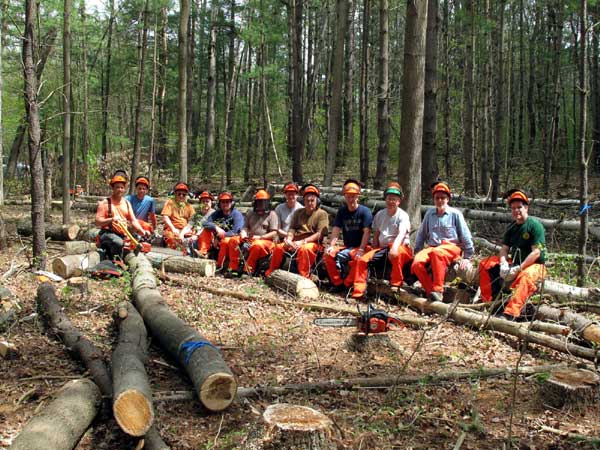
FLTC volunteers attend 2-day training course in safe and efficient use of chainsaws for clearing blowdown
on the Finger Lakes Trail – Photo R. Hopkins
| The interactive maps may not display correctly with Internet Explorer. For best results, use Firefox, Chrome or Safari. |
 This is an overview map of the portion of the North Country National Scenic Trail carried on the Finger Lakes Trail System. It shows only the main route of the NCNST; branches, loops, and spurs are not shown. The main FLT trail section is depicted in black for better visibility on various map backgrounds, but blazed in white on the ground. The Onondaga Trail section is depicted in blue and blazed in blue. Trail closures (hunting, logging, etc.) and recommended bypass routes are depicted as shown at right.
This is an overview map of the portion of the North Country National Scenic Trail carried on the Finger Lakes Trail System. It shows only the main route of the NCNST; branches, loops, and spurs are not shown. The main FLT trail section is depicted in black for better visibility on various map backgrounds, but blazed in white on the ground. The Onondaga Trail section is depicted in blue and blazed in blue. Trail closures (hunting, logging, etc.) and recommended bypass routes are depicted as shown at right.
When you zoom in on a trail section, trailheads, notices, and important infrastructure such as lean-tos are also shown.
| Click the menu button in the upper right for commands to Change the map background and Adjust map opacity, | |
| Click the button in the upper right to view the map in the full window. Then click the geolocate button to show your present GPS location on the map. | |
| The following symbols appear on the map (use the Hide/Show Symbols menu to control symbol visibility): | |
| Click for information about FLTC Maps, |
|
| Trailhead with parking. Click the symbol for more information. GPS coordinates, and for driving directions. | |
| Parking prohibited by law or landowner request. | |
| Camping: lean-tos, bivouacs, public and private campgrounds. See Lean-tos, Bivouacs, and Campgrounds for more information | |
| Hunting closures. See Hunting Season Schedules for more information. | |
| Potable water |
|
| ½-mile tickmark – hover over a tickmark to display the mileage along the trail segment (use Hide/Show Symbols menu to show the tickmarks) | |
| Connections to other long-distance hiking trails. | |
 |
Enter GPS coordinates (Latitude, Longitude) or an address (street address, town, or zip code) and click Find to recenter the map at that location. |
| Click on the center tool to show a small cross-hair in the center of the map. The tool shows the latitude and longitude coordinates of the center if you pan or scroll the map. | |
| Select a map background from the list in the upper right. Use the menu icons to find tools to measure distance and control background opacity. |
Current members of the Finger Lakes Trail are entitled to discounts on maps, stickers, and patches for sale on this website. A member coupon code is also provided for clothing and logo merchandise on the third-party website.
If your membership is current, you should see the ![]() symbol on discounted products. If you do not see this, please add this ($0.00) product to your EMPTY shopping cart. Then checkout. Log out of the website, log back in, and return to the store. You should now see the discount symbol and see discounted prices on your purchases.
symbol on discounted products. If you do not see this, please add this ($0.00) product to your EMPTY shopping cart. Then checkout. Log out of the website, log back in, and return to the store. You should now see the discount symbol and see discounted prices on your purchases.
Download a sample paper map in PDF form here.
The following are examples from a typical map:
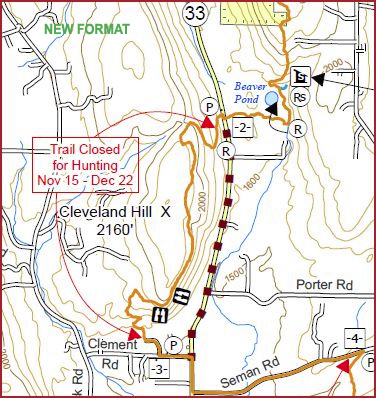
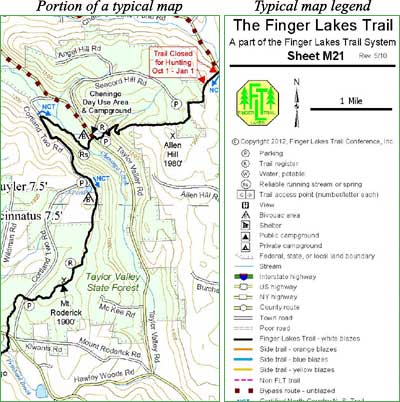
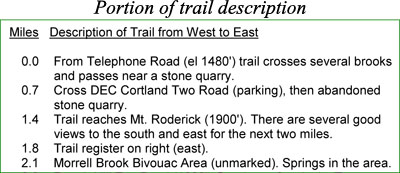
| CLASS OF 2024 | CLASS OF 2023 | |
| Ann Bayley | Donna Flood | |
| Lisette Brennan | Sharon Ray | |
| Christine DeGolyer | Willa Powell | |
| Tim Holahan | ||
| Terry Meacham | ||
| CLASS OF 2022 | CLASS OF 2021 | CLASS OF 2020 |
| Peg Fuller | Ann Bayley | Donna Flood |
| Scott Geiger | Rich Breslin | Laurie Ondrejka |
| Roger Hopkins | Scott Brooks | Mike Ogden |
| Tim Sweeney | Terry Meacham | Dave Newlun |
| Peter Wybron | ||
| CLASS OF 2019 | CLASS OF 2018 | CLASS OF 2017 |
| Roger Hopkins | Scott Brooks | Michael Ogden |
| Tim Sweeney* | Bob Kremens | Debra Nero |
| David Tuttle | Terry Meacham | Sieglinde Schwinge |
| Laurie Ondrejka | Wendy Stevenson | |
| Anna Keeton* | Donna Flood* | |
| CLASS OF 2016 | FUN CLASS OF 2015 | CLASS OF 2014 |
| Cate Concannon | Scott Brooks | Scott Bahantka |
| David Drum | Donna Coon* | Jon Bowen |
| Donna Flood | Roger Hopkins | Donna Cole |
| Roger Hopkins* | Terry Meacham | Melanie Okoniewski |
| David Tuttle | Laurie Ondrejka | Sigi Schwinge |
| CLASS OF 2013 | CLASS OF 2012 | CLASS OF 2011 |
| Cathy Concannon | Patricia Haynes | Jon Bowen |
| Phil Dankert | Roger Hopkins | Bill Coffin |
| David Drum | Phil Metzger | Terry Meacham |
| Donna Flood | John A-X Morris | Ray Recchia |
| Gail Merian | Ken Reek | Sigi Schwinge |
| CLASS OF 2010 | CLASS OF 2009 | CLASS OF 2008 |
| Phil Dankert | Richard Breslin | Dawn Bennett |
| Cheryl Peluso | Vicky Gaeta | Linda Cruttenden |
| Georgeanne Vyverberg | John A-X. Morris | Scott Lauffer |
| George Zacharek | Irene Szabo | Terry Meacham |
| Jacqui Wensich |
*Appointed
The FLTC offers downloadable files containing complete track and complete waypoint GPS data detailing all of the approximately 1,000 miles of the FLT, including main, loop, branch, and spur trails. In addition to GPS data, the downloadable files contain PDF images of the paper maps. GPS data is in the form of GPX files that can be loaded onto smart phones supporting GPX apps.
The free GPX Viewer from Vectura will enable you to view our maps on your Android phone. Tracks and waypoints are displayed on a variety of on-line map backgrounds along with your present location.
GPX Viewer Pro (license fee) has all of the features of GPX Viewer plus you can record the track of your hike. You can also download background maps to your device that can be viewed during your hike even if you have no cell phone coverage.
If you have experience using other smart phone apps, please let us know at [email protected].
The FLTC offers downloadable files containing complete track and complete waypoint GPS data detailing all of the approximately 1,000 miles of the FLT, including main, loop, branch, and spur trails. In addition to GPX data, the downloadable files contain PDF images of the paper maps. GPX files can be loaded onto color “field” (i.e. hiking, as opposed to automotive) GPS units. These GPX files can also be opened in Google Earth, so that you can view your hikes ahead of time (you can download the necessary software from Google Earth for free).
Detailed instructions for using the Track and Waypoint data in these GPX files are provided here.
Instructions for using the data with these recommended Garmin GPS units are also included:
Recent Garmin units: 62, 78, Oregon, Dakota, and Colorado. The Oregon and Dakota models are “touch screen” units (similar to auto GPS units) amd may be a little easier to learn how to use.
Older Garmin units: 60, 78 (instructions can also be used with Etrex Vista HCx and Etrex Legend HCx with slight modifications).
Bottom Line Recommended Unit? If you are a “techie” and can find it, grab the 60CSx at the present discounted prices. If you are a “newbie” you might prefer the touch screen Dakota or Oregon units (the Oregon 550 models can also take geotagged [lat-long embedded] photos).
Unless you have one of the recent Garmin units that has preloaded topo maps (indicated with a “t” at the end of the model number) you will want to download free topo maps for Garmin GPS units from GPS File Depot or other web sites. You can also purchase Garmin Topo U.S. 100K or similar Garmin software on DVD or micro SD card, but these can be expensive.
Delorme Units: These data also work with the Delorme GPS units PN-20 and PN-40, if you also have Delorme Topo software. However, expect loss of track and waypoint attributes (such as colors and symbols) with these and other GPS units that are not in the above recommended list.
Other Units: These GPX files may be compatible with other GPS units, but we have tested these files only with the recommended units listed above. If you are using another unit, it is up to you to determine that your GPS unit can use this GPX data. Before ordering the digital download map files, try downloading this sample GPX file, M09.gpx (our map M9), to ensure that it is compatible with your hardware and software.
As a Local Work Crew member you will join other volunteers recruited to work on trail projects that are beyond routine maintenance and the capabilities of the individual trail section adopter/steward. Projects might be repairing trail erosion, clearing downed trees, repairing bridges and structures, and the like. Projects are usually one day or less. Work parties are typically organized by the club or organization sponsoring the section or by the FLTC’s Regional Trail Coordinator for the area.
Many of our Local Work Crew members also have their own trail section they maintain.
Trail work projects are announced by e-mail and by local websites and newsletters. Let your trails chairperson, trail sponsor, or regional trail coordinator know if you will join the crew as this will greatly help with planning.
Your trails chairperson, trail sponsor, or regional trail coordinator will be responsible for reporting total hours of trail work, drive time, and administrative time.
To join your local trail work crew, simply contact your trails chairperson, trail sponsor, or regional trail coordinator and get your name on the distribution list.
